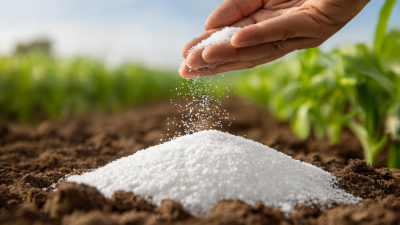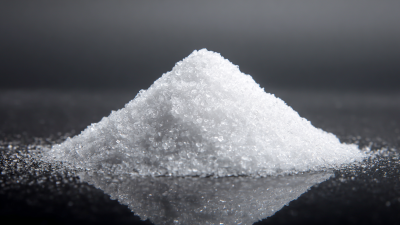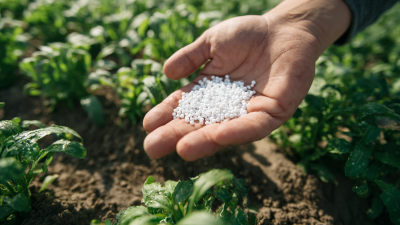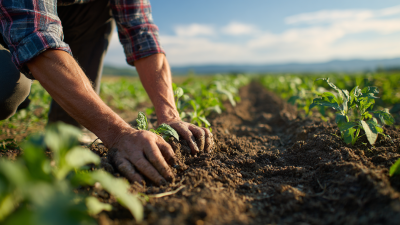Potassium Nitrate Fertilizer (KNO3) plays a crucial role in modern agriculture, enhancing crop yield and quality through its dual nutrient provision of potassium and nitrogen. According to the International Fertilizer Association (IFA), the demand for potassium nitrate is projected to rise significantly, driven by the increasing global food supply needs and the push for sustainable agricultural practices. A recent report indicates that the market for potassium nitrate fertilizers is expected to reach over $5 billion by 2025, reflecting its essential role in nutrient management for various crops.
Renowned agronomist Dr. Sarah Thompson notes, "The use of Potassium Nitrate Fertilizer not only improves the physiological growth of plants but also enhances their resistance to stress conditions." This sentiment underscores the importance of potassium nitrate in promoting not just higher yields but also healthier crops that can withstand environmental challenges.
With its unique ability to dissolve in water quickly, Potassium Nitrate Fertilizer is particularly effective in fertigation systems, providing farmers with a reliable and efficient means of delivering nutrients to their plants. This comprehensive guide aims to delve into the benefits, uses, and best application practices of potassium nitrate, equipping agricultural professionals with the knowledge needed to optimize their crop production strategies for a sustainable future.

Potassium nitrate fertilizer is a key player in promoting plant health and growth, offering a balanced supply of two essential nutrients: potassium and nitrogen. Potassium plays a crucial role in various physiological processes, including water regulation, photosynthesis, and enzyme activation. This nutrient enhances the plant's ability to withstand stress, including drought and disease, resulting in stronger and more resilient crops. Nitrogen, on the other hand, is vital for synthesizing proteins and chlorophyll, driving growth and development, particularly in leafy vegetables and grasses.
The benefits of potassium nitrate extend beyond just nutrient supply; it also stimulates root development and improves overall plant vigor. By enhancing nutrient uptake, this fertilizer helps plants efficiently utilize other essential elements from the soil. This synergistic effect leads to improved yields and better quality produce, making potassium nitrate a preferred choice among farmers and gardeners aiming for optimal growth. Additionally, its compatibility with various crops allows for customized applications, catering to specific growth stages and soil conditions, ultimately ensuring that plants receive the right nutrients when they need them most.
Potassium nitrate, often referred to as saltpeter, plays a crucial role in both agriculture and horticulture. Its high potassium content makes it an effective nutrient provider, promoting strong root development, enhancing fruit quality, and facilitating overall plant growth. This dual-action fertilizer is particularly beneficial during the flowering and fruiting stages of plants, aiding in energy transfer and ensuring robust yield production.
Tips: When using potassium nitrate, it's essential to apply it at the right growth stage. For instance, incorporating it into the soil before planting can set up plants for strong early growth, while a side-dressing during flowering can help maximize fruit development.
In addition to its broad applications in various crops, potassium nitrate is particularly advantageous for leafy greens and fruits, as it supports chlorophyll production and vibrant color development. The quick-release nature of this fertilizer ensures that plants can readily absorb the nutrients, leading to healthier and more productive yields.
Tips: Always conduct a soil test before applying potassium nitrate to understand existing nutrient levels, ensuring you don’t over-fertilize, which can harm plant health and lead to nutrient runoff.
| Dimension | Details |
|---|---|
| Chemical Composition | KNO3 (Potassium Nitrate) |
| Nutrient Content | 13% Nitrogen, 46% Potassium |
| Key Benefits | Promotes flowering, enhances fruit quality, improves drought tolerance |
| Common Uses | Vegetable and fruit crops, ornamental plants, turf management |
| Application Methods | Soil application, foliar spray, fertigation |
| Recommended Rates | 50-150 lbs/acre depending on crop |
| Safety Precautions | Avoid inhalation, use gloves and masks during handling |
| Environmental Impact | Risk of leaching; use as per soil test recommendations |
When applying potassium nitrate fertilizer, several techniques can enhance its efficiency and promote optimal plant growth. One effective method is the split application technique, where the total amount of fertilizer is divided into two or more applications throughout the growing season. This allows plants to better absorb the nutrients when they need them most, particularly during critical growth stages such as flowering or fruiting. Additionally, incorporating potassium nitrate into irrigation systems can facilitate even nutrient distribution and minimize wastage, as it dissolves readily in water.
Another vital aspect of application is timing. Applying potassium nitrate during the early morning or late afternoon can help reduce the risk of volatilization and nutrient loss due to high temperatures. It's also essential to consider soil moisture levels; applying the fertilizer to moist soil helps prevent leaching and ensures that the nutrients remain accessible to the root system. Utilizing soil testing to determine nutrient needs can further optimize the application rates and timing, tailoring the use of potassium nitrate to meet specific crop requirements and ultimately improving yield and quality.

Potassium nitrate, a vital fertilizer in agriculture, is composed of potassium, nitrogen, and oxygen, making it an essential source of both macronutrients for plants. The nutritional composition of potassium nitrate offers a balanced supply of potassium, which is crucial for various plant functions, including water regulation, enzyme activation, and the synthesis of proteins and starches. Its high solubility allows for easy absorption by plants, thereby promoting overall growth and enhancing crop yields.
Beyond the basics of its composition, potassium nitrate plays a significant role in nutrient management and crop health. As a readily available source of nitrogen, it supports vegetative growth, while its potassium content contributes to fruit quality and disease resistance. This dual functionality makes potassium nitrate especially useful during critical growth stages, such as flowering and fruiting. Employing potassium nitrate can improve not only the quantity of harvest but also the quality, ensuring that crops are robust and resilient to stress factors. Understanding its benefits and applications is essential for effective agricultural practices.
When using potassium nitrate fertilizer, it is crucial to consider its environmental impact. Excessive application can lead to nutrient leaching into nearby waterways, resulting in eutrophication, which disrupts aquatic ecosystems. To minimize this risk, farmers should conduct soil tests to determine existing nutrient levels, allowing for precise application rates that match crop needs. Implementing best management practices, such as split applications, can also reduce runoff and enhance nutrient efficiency.
Additionally, incorporating potassium nitrate into a broader nutrient management strategy is essential. This involves rotating crops and using cover crops to improve soil health and reduce reliance on synthetic fertilizers. Adopting integrated pest management practices can further decrease the need for chemical inputs, promoting a more sustainable agricultural system. By prioritizing environmental considerations, farmers can effectively utilize potassium nitrate while safeguarding natural resources for future generations.






